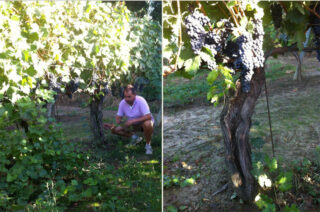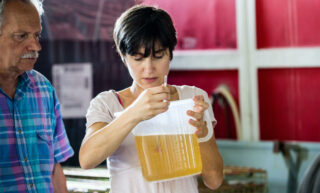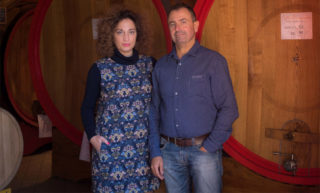Merging the gap between Modernity and Tradition
Over lunch at Azienda Agricola Vietto in the town of Novello, Davide Vietto, the friendly vintner who visibly likes his wine, pasta and affettati (cold cuts), remembers the dramatic year of 1986 as a turning point for Barolo. It was not only the year of the Italian wine scandal, but also the year of the Chernobyl disaster and a devastating hailstorm in the area on 29 May. Davide credits Domenico Clerico, a winemaker from the neighboring commune of Monforte, for his visionary response to the events. He was convinced that the Barolo vintners should focus on quality, yield reduction, modern technique, and a more approachable style of Barolo. Just one year later, at Vinitaly, Davide says, there was a buzz around Barolo, and its name was established.
Barolo is typically discussed in terms of ‘traditionalists’ and ‘modernists’ (Clerico belonged to the latter), but over the years the differences have faded, as we saw on a recent trip to Italy’s possibly most lauded wine region. But new challenges are looming on the horizon.
From poverty to luxury
When we walk into the cellar on a cold December morning, Silvia, Davide’s wife, recommends that I read La Malora, a book from 1954 by Beppe Fenoglia, an author from nearby Alba. The book paints a grim picture of the poverty in Barolo. In the mid-fifties it was more lucrative to keep some animals than to grow grapes. In those days the appellation was dominated by Dolcetto and Barbera grown by small farmers. The wines they made were for personal use. If they weren’t, they were delivered to mostly local customers, often in demijohns.
Nowadays Barolo is known for (and largely planted to) Nebbiolo, and some bottles fetch astronomical prices. Barolo has become a luxury product and a product for special occasions. Or as Davide says: “A bottle of Barolo is not just a wine. It requires a special moment to appreciate it. You open it in the evening after dinner with friends to create memories.” In other words, it needs the attention it deserves.
Just a list of vineyards
Not unlike Burgundy, Barolo’s star started to rise after the Second World War.
When vintners learned how to tame Nebbiolo’s firm tannins and generous acidity, its wealth of flavors and aromas finally had a chance to shine. As a result, Nebbiolo became the dominant variety at the expense of Dolcetto and Barbera.
Most of the Barolo appellation has now been divided up in so-called Menzioni Geografiche Aggiuntive (MGAs) or additional geographical indications, delimited vineyards of which the name may be mentioned on the label. They should not be understood as a classification. Unlike the four-tier classification in Burgundy (Grand Cru, Premier Cru, communal, regional), which give an idea of the quality of the grapes and the wine made from them, there is no hierarchy in the 181 MGAs (170 MGAs plus the 11 communes which are MGAs by themselves). “It’s just a list of vineyards,” explains Maria Teresa Mascarello of the illustrious winery Bartolo Mascarello in the village of Barolo. You wonder if it isn’t yet time to come up with a structured approach, not unsimilar to what ÖTW is doing in Austria, to establish what their very best and second-best vineyards are.
To make things even more complicated, the size of the MGAs differs enormously. With barely more than 1 hectare, the Bricco Rocche MGA in Castiglione Falletto, one of the eleven villages of the appellation, is a mere dwarf compared to the 340-hectare Bussia MGA in Monforte d’Alba. Given the complicated geography of the Barolo hills, even a 1-hectare vineyard can have differences in exposition, elevation and soil – just imagine how bewildering the number of permutations in a 340-hectare MGA are.
The human factor of terroir
This means the consumer has to be well-informed, not only about the differences between the MGAs, but also within them, to make an educated decision about the wine to buy. Aside from the fact that you also need to know the approach of the winemaker (think modernist vs traditionalist). While the typical modernist uses new barrique for ageing concentrated, fruit-driven wines, a traditionalist prefers to mature the gently extracted wines in large botti. But there are dozens of other criteria: the choice between indigenous vs industrial yeast, the date of harvest, the type of pruning system, the use of enzymes, etc. are all human decisions. The human factor in terroir is an accepted parameter, but the importance sometimes seems to be underestimated.
Cannubi vineyards ©Bartolo Mascarello
Balance is everything
Maria Teresa Mascarello, the heir of Bartolo Mascarello, is a staunch defender of traditional winemaking. Impeccably dressed, casual chic but sporty enough to give us a tour of the cellar, she receives us in the smartly decorated tasting room. Ever since its establishment in 1919, the winery measures 5 hectares. “We always intended to be a small, artisan estate. We don’t follow trends,” she asserts. This not only means she uses botti (large neutral Slavonian oak casks), but also that she blends her Barolo from different vineyards. Despite the trend for single vineyard wines, Mascarello holds on to the old habit of making one Barolo DOCG from her four vineyards, three in Barolo (San Lorenzo, Rué and Cannubi), and one in La Morra (Rocche dell’Annunziata). “Each one adds something to the blend. The more clayey vineyard Rué gives body and freshness, while the sandier Cannubi provides delicacy and elegance.” Balance is everything for Mascarello. And indeed, although different in character, both the 2018 and 2019 I tasted were perfect specimens of fragrant, long, harmonious, structured but juicy, and approachable but storable Barolo.
New challenges
I asked her what the big themes for Barolo are going to be. “I don’t have a crystal ball,” she admits, “but the climate is going to be a big issue, in particular the rising temperatures and the shortage of water”. She also worries about the increasing areas planted with grapes. “Traditionally the region has a mixed landscape,” she says. “There were vineyards, hazelnut and fruit trees, and forest. Now it’s mostly vineyards, predominantly Nebbiolo.” Indeed, one of the first things that strikes you when you drive around the undeniably very pretty region is a sense of monoculture. Vineyards as far as the eye can reach. “In barely twenty years the number of bottles of Barolo DOCG has more than doubled. The authorities often give permission to plant Nebbiolo just for Langhe Nebbiolo (the regional wine), but then after some years, grapes from the same plot of land get upgraded to be used for Barolo DOCG.” All this has led to less Dolcetto, Freisa and Barbera, to a loss of biodiversity and to a small lake of Barolo of mediocre quality. “You now see Barolo for less than 10 euro in the supermarket,” Maria Teresa says with barely concealed resentment. But there is hope, a small but increasing number of vintners are working according to tradition and with respect for nature. Maria Teresa mentions Trediberri, Luigi Oddero, La Briccolina, Lalù, Crissante Alessandria and Philine Isabelle Dienger.
Barolo monoculture ©Bart de Vries
At Vietto, the winery in Novello (mini profile below, not to be confused with Vietti from Castiglione Falletto), they agree with Maria Teresa’s thoughts about the climate. Vineyard management has to be adjusted to deal with rising temperatures. Until two years ago, 88-year-old Giovanna Vietto, Davide’s mother, could be found in the vineyards, but since then, her son and granddaughter Alessandra have taken over most of the responsibilities. They cut away fewer leaves to create better protection against the sun, and between the rows they grow cover crops to avoid evaporation. But Vietto, with their key vineyards in the Panerole MGA, may also benefit from its location on the southern end of the Barolo appellation that receives more cool alpine air.
Although Davide says Bartolo Mascarello is a model and touchstone for him, the production methods for his Barolo include the use of new barriques. However, the ‘Barolo Wars’ are mostly over. There is no good or bad in the discussion about traditional or modern anymore. Mascarello may be proudly and tenaciously traditional, but many vintners have learned from each other and combine the best of both worlds, as Vietto proves. Energy can now be redirected to the challenges ahead.
Giovanna Vietto with a bottle of Nas-cëtta named after her ©Bart de Vries, Az. Ag. Vietto
Azienda Agricola VIETTO
Vietto is a traditional, family-run agricultural business (azienda agricola). Because local women weren’t interested in marrying into a family of contadini and having to work in the fields, Pietro Vietto Sr., one of the founding members of the Cantina Soziale della Terra di Barolo, had to travel to Calabria to find his bride Giovanna. Giovanna, on the contrary, had made a name for herself for picking olives fast and efficiently, a skill that she later used to gather the hazelnuts in Piedmont.
After the early death of her husband, Giovanna took over the responsibility for the farm. To provide for her four young children – the oldest, Davide, was 19 – she could have decided to sell the business, but to honor the hard work of her husband and because of her own attachment to the land she kept on growing grapes.
When they were old enough, Davide and his brother Luigi joined their mother, while they also worked for renowned wineries in the region like G.D. Vajra. In 2000 Davide and his brother decided to start bottling under their own label, but at heart the winery remains an agricultural business. More than half of the grapes are still sold to a cooperative. “I learn a great deal about grape growing from working with them,” Davide says.
Now the next generation, Davide and Silvia’s offspring, Pietro Jr. and Alessandra, are getting involved in the winery as well. Alessandra is already managing the vineyards full time. Pietro Jr., who is currently doing an internship with Mauro Molino, will eventually be in charge of the cellar.
Giovanna praises the attachment of the piemontesi to their region. “Children should stick to their roots,” she claims. “All my four children do,” she says, contentedly seated next to the roaring wood burner. Although not actively involved in the winery anymore, Giovanna still presides as a benevolent matriarch over her land and family.
At 88 she is still sharp and witty. About climate change she commented: “Come ha cambiato la temperature, ha cambiato la gente.” (As temperature has changed, people have changed.) Although she has always been a hardworking woman with humble roots who faces life with common sense, she deplores modern manners. Ciao and tu (informal you)? For her it is Buongiorno and Lei (formal you).
The Vietto winery, based in the hamlet of Panerole (part of the commune of Novello), counts 14 hectares, 5 of which are in the Panerole MGA. They grow four different varieties, Nebbiolo, Barbera, Dolcetto and Nascetta (the only native white variety), from which they produce six different wines.
PANEROLE
Panerole is an MGA of 41,5 hectare in the commune of Novello, located next to the famed Ravera vineyard. The exposure is mostly south, with parts facing southwest and southeast. Half of the grapes are earmarked for Barolo Nebbiolo, a quarter goes into the Langhe Nebbiolo. Small parts of the vineyard are planted to Barbera, Dolcetto and white grapes for Langhe Bianco. According to Vietto, the Barolos from the Panerole MGA often provide a touch of mint, which he attributes to Panerole’s relatively cool climate. The tannins tend to develop slowly. They remain firm quite long but are fine and elegant. The primary fruit aromas and flavors usually develop a little faster.
A version of this article has been published in Norwegian in Apéritif (issue 2/2023).







Comments